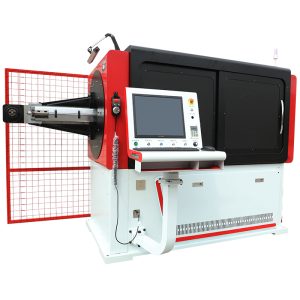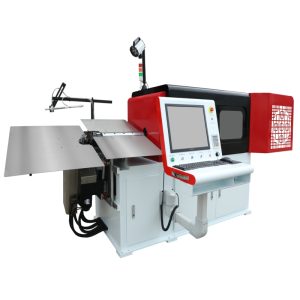One-stop Bending Solutions For Wires, Tubes And Pipes
One-stop Bending Solutions For Wires, Tubes And Pipes
In the modern hardware processing industry, as market demands for product precision, production efficiency, and cost control continue to increase, traditional manual or semi-mechanized wire processing methods have gradually become unable to meet the needs of enterprise development. As professional processing equipment that integrates automation and intelligence, automatic wire bending machines, with their precise control technology, stable operating performance, and efficient production capacity, have become key equipment for hardware companies to achieve industrial upgrading and enhance their core competitiveness. They are widely used in a variety of fields, including automotive parts, home appliance accessories, hardware tools, and medical devices. They can complete complex processing procedures such as bending, forming, and cutting wires, providing strong support for enterprises’ large-scale production and high-quality development.

1. Reducing Labor Costs
Amidst the current socioeconomic development, while talent quality continues to improve, human resource costs are also showing a trend of continued growth. For companies that traditionally rely on manual labor for wire processing, labor costs are no longer a negligible expense; they have become a significant factor impacting overall operating costs and profit margins. Furthermore, companies face challenges with recruiting and high staff turnover, requiring significant investment of time and effort in employee recruitment, training, and management.
Automated or semi-automated wire bending machines can fundamentally change this situation. They utilize advanced CNC systems to automate the processing process, allowing a single machine to replace multiple traditional manual operators, significantly reducing the company’s annual workforce and recruitment needs. This not only directly reduces monthly and annual labor costs related to employee salaries, social security, and benefits, but also allows the saved funds and resources to be reinvested in the recruitment and development of high-end technical talent, enhancing the professional quality and innovation capabilities of the company’s core technical teams. Furthermore, this reduces production interruptions and training costs caused by staff turnover, optimizes the allocation of corporate resources, and lays a solid foundation for the company’s long-term and stable development.
2. Effectively Reduce the Probability of Work-Related Accidents
In traditional manual machining, the complex wire processing process requires close contact between the operator and the machine and workpiece, and requires high precision and proficiency. Improper operation, lack of concentration, or inadequate equipment protection can easily lead to workplace accidents such as pinched fingers, scratches, and burns, endangering personal safety. These accidents not only cause significant pain and loss to employees and their families, but also disrupt production, resulting in high costs for workers’ compensation and equipment repairs. They can also negatively impact the company’s social image and reputation.
Automatic wire bending machines utilize a fully automated production model. From wire feeding, bending, forming, to cutting, the entire process is automatically performed by a CNC system according to preset parameters and programs. Operators only need to set parameters and debug the program before starting the machine, and perform real-time monitoring and simple auxiliary operations during production, without having to directly touch the processing area. This operating model minimizes contact with hazardous processing areas, fundamentally reducing the likelihood of workplace accidents and significantly reducing the probability of workplace accidents. The equipment is also equipped with comprehensive safety features, including safety doors, emergency stop buttons, and photoelectric sensors. If an abnormality is detected, the equipment will automatically shut down, further ensuring operator safety and process stability. Furthermore, the automated production model ensures that machining efficiency is unaffected by human factors, ensuring that production tasks are completed on time.
3. Significantly Improve Production Efficiency
Production efficiency is one of the key factors that gives companies a competitive edge in the market. Traditional manual processing is limited by factors such as speed, physical strength, energy, and individual skill levels, resulting in low and unstable processing efficiency. Operators are prone to fatigue and exhaustion after long hours, leading to slower processing speeds and reduced precision. Furthermore, uncontrollable factors such as leave, absenteeism, and staff transfers can affect production schedules, causing fluctuations and making it difficult to meet the needs of large-scale, high-volume production.
Automated wire bending machines, with their automated operation advantages, have achieved a substantial leap in production efficiency. First, the processing speed of the equipment is precisely controlled by a CNC system, enabling continuous operation according to the optimal processing path and speed. This significantly improves processing efficiency compared to traditional manual operations. For example, in the same amount of time, an automatic wire bending machine can achieve several or even dozens of times the processing output of traditional manual operations. Secondly, the equipment ensures the continuity and stability of the machining process, unaffected by factors such as operator fatigue, mental fatigue, and absences. This allows for 24-hour uninterrupted production (requiring only a small number of personnel for shift monitoring), significantly improving equipment utilization and overall production. Furthermore, the CNC system precisely controls machining parameters, ensuring the accuracy and consistent quality of each workpiece. This reduces scrap caused by human error, avoids the waste of raw materials, and indirectly improves production efficiency. Whether it’s small-batch, multi-variety customized production or large-scale, standardized production, automatic wire bending machines can efficiently complete the task and meet the diverse production needs of enterprises.
4. Improving Product Quality and Stability
Product quality is the foundation of a company’s survival and development. Only by ensuring stable and reliable product quality can we earn customer trust and market recognition. In traditional manual processing, product quality is highly dependent on the operator’s skill level, work attitude, and concentration. Processing quality can vary between operators, and even within the same operator over time. This leads to problems such as unstable product precision, large dimensional deviations, and poor appearance, making it difficult to meet market demand for high-quality products. Furthermore, the relatively complex structure of traditional mechanical equipment makes fault detection and repair difficult. Once a fault occurs, repairs are often time-consuming and costly, impacting production schedules.
Automatic wire bending machines utilize advanced CNC technology and high-precision mechanical structures to precisely control every step of the processing process, such as wire feed length, bend angle, and forming position. This ensures that every finished workpiece exhibits extremely high precision and consistency, effectively improving product quality and stability. Furthermore, the equipment features comprehensive debugging and monitoring capabilities. Operators can easily adjust and optimize processing parameters through a human-machine interface, monitor the equipment’s operating status and processing progress in real time, and promptly identify and resolve production issues. At the same time, the automatic wire bending machine is equipped with an advanced self-test program that can automatically test its own performance indicators before starting and during operation, such as the motor operating status, transmission system accuracy, sensor sensitivity, etc. Once an abnormality is detected, it will immediately issue an alarm signal and stop operation, allowing operators to carry out repairs and maintenance in a timely manner to avoid the expansion of the fault. This proactive prevention and real-time monitoring model not only reduces the failure rate and maintenance rate of the equipment, but also extends the service life of the equipment and reduces the company’s cost expenditure on equipment repair and replacement.
5. Extending Equipment Lifecycle
Amid the global advocacy for green environmental protection and sustainable development, businesses are increasingly prioritizing environmental protection and energy conservation while pursuing economic benefits. Traditional wire processing equipment mostly utilizes hydraulic or other energy-intensive drive systems. These systems not only consume significant amounts of energy (such as electricity and fuel) during operation, but also generate significant noise pollution and oil emissions, which do not meet the requirements of modern enterprises for green production. Furthermore, mechanical components of traditional equipment are susceptible to wear under long-term, high-load operation, shortening the equipment’s lifespan and increasing equipment replacement costs.
Automatic wire bending machines offer significant advantages in terms of environmental protection and energy conservation. These machines are driven by high-performance servo motors, which feature fast response, high precision, and low energy consumption. They automatically adjust output power based on processing demands, achieving intermittent operation, reducing energy consumption when no processing is required. During processing, power is precisely supplied based on load size, avoiding energy waste and significantly saving electricity and fuel compared to traditional equipment. The servo motor generates extremely low operating noise, and the optimized sound insulation and vibration reduction design throughout the machine significantly reduces noise pollution during operation, creating a quiet and comfortable working environment for operators and meeting national environmental protection standards and corporate green production requirements. Furthermore, the automatic wire bending machine’s mechanical structure is constructed of high-strength, wear-resistant, high-quality materials. Combined with an advanced lubrication system and maintenance-friendly design, this reduces wear and aging of mechanical components, effectively extending the equipment’s lifecycle and reducing the frequency and cost of equipment upgrades for companies, achieving a win-win situation for both economic and environmental benefits.

With these five core advantages, the automatic wire bending machine addresses numerous pain points for hardware manufacturers, including high labor costs, significant production safety risks, low production efficiency, unstable product quality, and high energy consumption and pollution. It is an ideal choice for companies seeking to upgrade their industry and enhance their market competitiveness. If you have any inquiries regarding automatic wire bending machine models, performance, pricing, or application solutions, please feel free to contact us. We will provide professional consulting services and customized solutions to help your company achieve high-quality development.
Previous Articles:
Precautions for operating automatic wire bending machine
How to choose a fully automatic pipe bending machine suitable for shipbuilding?
Our equipment has CE, ISO quality inspection certificate, so the quality is guaranteed to be cost-effective. According to different processing requirements, machines can be customized to fit for your usage, to provide customized services. In the processing period, we strictly control the production process, to ensure the quality of clearance, standardize the process, strict implementation.
